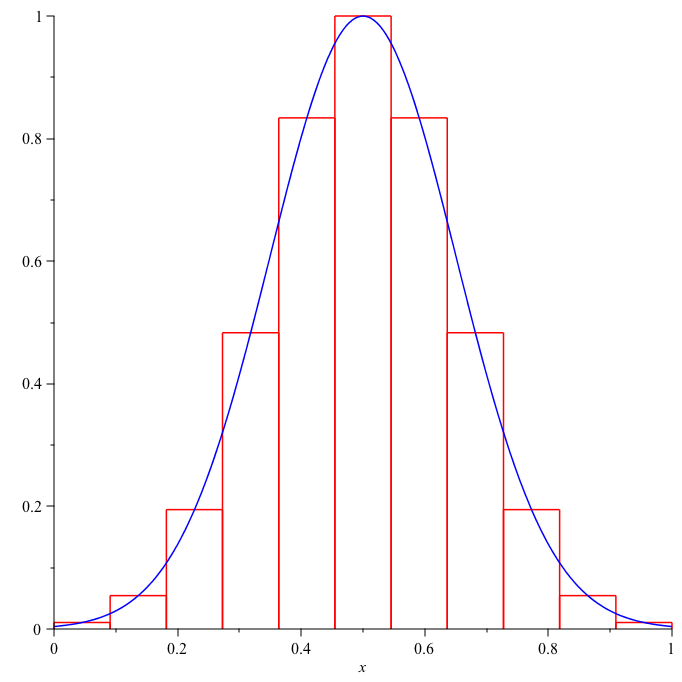The Gaussian integral is not only important in mathematics but is also extremely important in studying physics, for example, quantum mechanics, quantum field theory, and statistical mechanics. Let us begin with the most simple Gaussian integral
$$G=\int_{-\infty}^\infty e^{-x^2}dx$$
This is not an easy integral to calculate but it can be done easily if we extend it to an integral in two-dimensions as
\begin{align*} G^2&=\int_{-\infty}^\infty e^{-x^2}dx\int_{-\infty}^\infty e^{-y^2}dy\\ &=\int_{-\infty}^\infty\int_{-\infty}^\infty e^{-(x^2+y^2)}dxdy \end{align*}
Now, in term of the polar coordinates, $x=r\cos\theta$, $y=r\sin\theta$ and the area element is $dA=rdrd\theta$, so $G^2$ can be written as
\begin{align*} G^2&=\int_0^{2\pi}\int_0^\infty re^{-r^2}drd\theta\\ &=\pi \end{align*}
The integral $\int_0^\infty re^{-r^2}dr$ can be easily evaluated using the substitution $u=-r^2$ and its value is $\frac{1}{2}$. Now, we obtain
$$G=\int_{-\infty}^\infty e^{-x^2}dx=\sqrt{\pi}$$
From this you can evaluate more complicated Gaussian integrals using a simple substitution and/or some algebra. For example, $\int_{-\infty}^\infty e^{-ax^2}dx$ for a positive real number $a$ can be evaluated easily by a simple substitution $u=\sqrt{a}x$:
\begin{equation}
\begin{aligned}
\int_{-\infty}^\infty e^{-ax^2}dx&=\frac{1}{\sqrt{a}}\int_{-\infty}^\infty e^{-u^2}du\\
&=\sqrt{\frac{\pi}{a}}
\end{aligned}\label{eq:gaussint}
\end{equation}
If $a=\frac{1}{2}$, then $\int_{-\infty}^\infty e^{-\frac{1}{2}x^2}dx=\sqrt{2\pi}$. Normally one will have to use the integration by parts to calculate $\int_{-\infty}^\infty x^2e^{-x^2}dx$ or $\int_{-\infty}^\infty x^4e^{-x^2}dx$. There is a neat trick of evaluating such integrals by differentiating \eqref{eq:gaussint} with respect to $a$:
$$\frac{d}{da}\int_{-\infty}^\infty e^{-ax^2}dx=-\int_{-\infty}^\infty x^2e^{-ax^2}dx$$
and
$$\frac{d}{da}\sqrt{\frac{\pi}{a}}=-\frac{1}{2a}\sqrt{\frac{\pi}{a}}$$
Thus, we have
\begin{equation}
\label{eq:gaussint2}
\int_{-\infty}^\infty x^2e^{-ax^2}dx=\frac{1}{2a}\sqrt{\frac{\pi}{a}}
\end{equation}
For $a=1$, we obtain
$$\int_{-\infty}^\infty x^2e^{-x^2}dx=\frac{\sqrt{\pi}}{2}$$
Differentiating \eqref{eq:gaussint2} with respect to $a$ leads to
\begin{equation}
\label{eq:gaussint3}
\int_{-\infty}^\infty x^4e^{-ax^2}dx=\frac{3}{4a^2}\sqrt{\frac{\pi}{a}}
\end{equation}
For $a=1$, we obtain
\begin{equation}
\label{eq:gaussint4}
\int_{-\infty}^\infty x^4e^{-x^2}dx=\frac{3}{4}\sqrt{\pi}
\end{equation}
I learned this trick from the book Quantum Field Theory in a Nutshell by Anthony Zee. Another important variation is
\begin{equation}
\label{eq:gaussint5}
\int_{-\infty}^\infty e^{-ax^2+bx}dx
\end{equation}
This integral can be evaluated from \eqref{eq:gaussint} with a little bit of algebra. First, by completing the square, we write
\begin{align*} -ax^2+bx&=-a\left(x^2-\frac{b}{a}x\right)\\ &=-a\left(x^2-\frac{b}{a}x+\left(-\frac{b}{2a}\right)^2-\left(-\frac{b}{2a}\right)^2\right)\\ &=-a\left(x-\frac{b}{2a}\right)^2+\frac{b^2}{4a} \end{align*}
Now, \eqref{eq:gaussint5} is evaluated as
\begin{align*} \int_{-\infty}^\infty e^{-ax^2+bx}dx&=\int_{-\infty}^\infty e^{-a\left(x-\frac{b}{2a}\right)^2+\frac{b^2}{4a}}dx\\ &=e^{\frac{b^2}{4a}}\int_{-\infty}^\infty e^{-a\left(x-\frac{b}{2a}\right)^2}dx\\ &=e^{\frac{b^2}{4a}}\int_{-\infty}^\infty e^{-au^2}du\ \left[u=x-\frac{b}{2a}\right]\\ &=e^{\frac{b^2}{4a}}\sqrt{\frac{\pi}{a}} \end{align*}
This time let us try to calculate
\begin{equation}
\label{eq:gaussint6}
\int_{-\infty}^\infty\int_{-\infty}^\infty\int_{-\infty}^\infty (x^2+y^2+z^2)e^{-(x^2+y^2+z^2)}dxdydz
\end{equation}
You stumble upon this type of integral, for example, in a derivation of the Maxwell-Boltzmann statistics in the form of
$$\int d^3p\frac{p^2}{2m}\exp\left(-\beta\frac{p^2}{2m}\right)$$
The integral \eqref{eq:gaussint6} can be easily evaluated using the spherical coordinates:
\begin{align*} x&=r\sin\theta\cos\phi\\ y&=r\sin\theta\sin\phi\\ z&=r\cos\theta\ \end{align*}
where
$$0\leq r<\infty,\ 0\leq\theta\leq\pi,\ 0\leq\theta\leq 2\pi$$
The volume element in the spherical coordinates is $dV=r^2dr\sin\theta d\theta d\phi$, so
\begin{align*} \int_{-\infty}^\infty\int_{-\infty}^\infty\int_{-\infty}^\infty (x^2+y^2+z^2)e^{-(x^2+y^2+z^2)}dxdydz&=\int_0^{2\pi}\int_0^\pi\int_0^\infty r^4e^{-r^2}dr\sin\theta d\theta d\phi\\&=\frac{3}{2}\pi\sqrt{\pi} \end{align*}
We obtain
$$\int_0^\infty r^4e^{-r^2}dr=\frac{3}{8}\sqrt{\pi}$$
using \eqref{eq:gaussint4}.

